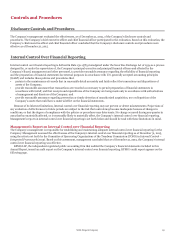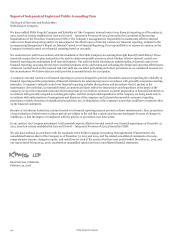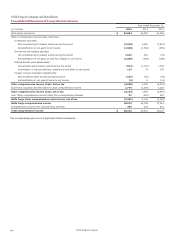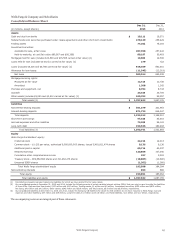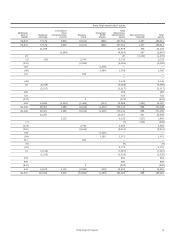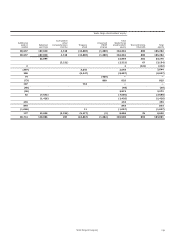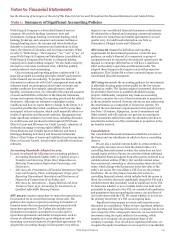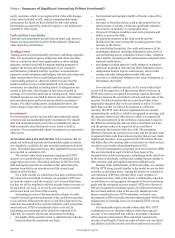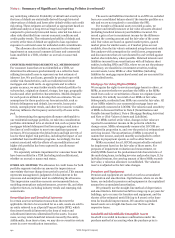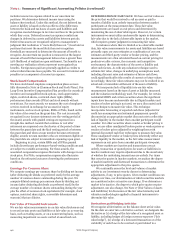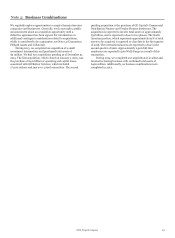Wells Fargo 2015 Annual Report Download - page 143
Download and view the complete annual report
Please find page 143 of the 2015 Wells Fargo annual report below. You can navigate through the pages in the report by either clicking on the pages listed below, or by using the keyword search tool below to find specific information within the annual report.
Notes to Financial Statements
See the Glossary of Acronyms at the end of this Report for terms used throughout the Financial Statements and related Notes.
Note 1: Summary of Significant Accounting Policies
Wells Fargo & Company is a diversified financial services
company. We provide banking, insurance, trust and
investments, mortgage banking, investment banking, retail
banking, brokerage, and consumer and commercial finance
through banking stores, the internet and other distribution
channels to consumers, businesses and institutions in all 50
states, the District of Columbia, and in foreign countries. When
we refer to “Wells Fargo,” “the Company,” “we,” “our” or “us,” we
mean Wells Fargo & Company and Subsidiaries (consolidated).
Wells Fargo & Company (the Parent) is a financial holding
company and a bank holding company. We also hold a majority
interest in a real estate investment trust, which has publicly
traded preferred stock outstanding.
Our accounting and reporting policies conform with U.S.
generally accepted accounting principles (GAAP) and practices
in the financial services industry. To prepare the financial
statements in conformity with GAAP, management must make
estimates based on assumptions about future economic and
market conditions (for example, unemployment, market
liquidity, real estate prices, etc.) that affect the reported amounts
of assets and liabilities at the date of the financial statements,
income and expenses during the reporting period and the related
disclosures. Although our estimates contemplate current
conditions and how we expect them to change in the future, it is
reasonably possible that actual conditions could be worse than
anticipated in those estimates, which could materially affect our
results of operations and financial condition. Management has
made significant estimates in several areas, including allowance
for credit losses and purchased credit-impaired (PCI) loans
(Note 6 (Loans and Allowance for Credit Losses)), valuations of
residential mortgage servicing rights (MSRs) (Note 8
(Securitizations and Variable Interest Entities) and Note 9
(Mortgage Banking Activities)) and financial instruments
(Note 17 (Fair Values of Assets and Liabilities)) and income taxes
(Note 21 (Income Taxes)). Actual results could differ from those
estimates.
Accounting Standards Adopted in 2015
In 2015, we adopted the following new accounting guidance:
• Accounting Standards Update (ASU or Update) 2014-11,
Transfers and Servicing (Topic 860): Repurchase-to-
Maturity Transactions, Repurchase Financings, and
Disclosures;
• ASU 2014-08, Presentation of Financial Statements (Topic
205) and Property, Plant, and Equipment (Topic 360):
Reporting Discontinued Operations and Disclosures of
Disposals of Components of an Entity; and
• ASU 2014-01, Investments – Equity Method and Joint
Ventures (Topic 323): Accounting for Investments in
Qualified Affordable Housing Projects.
ASU 2014-11 requires repurchase-to-maturity transactions to
be accounted for as secured borrowings versus sales. The
guidance also requires separate accounting for transfers of
financial assets that are executed contemporaneously with
repurchase agreements. The Update also includes new
disclosures for transfers accounted for as sales and for
repurchase agreements and similar arrangements, such as
classes of collateral pledged for gross obligations and the
remaining contractual maturity of repurchase agreements. We
adopted the accounting changes in first quarter 2015 with no
impact to our consolidated financial statements or disclosures.
We adopted the collateral and remaining contractual maturity
disclosures for repurchase and similar agreements in second
quarter 2015. For additional information, see Note 14
(Guarantees, Pledged Assets and Collateral).
ASU 2014-08 changes the definition and reporting
requirements for discontinued operations. Under the new
guidance, an entity’s disposal of a component or group of
components must be reported in discontinued operations if the
disposal is a strategic shift that has or will have a significant
effect on the entity’s operations and financial results. We
adopted these changes in first quarter 2015 with prospective
application. This Update did not have a material impact on our
consolidated financial statements.
ASU 2014-01 amends the accounting guidance for investments
in affordable housing projects that qualify for the low-income
housing tax credits. The Update requires incremental disclosures
for all entities that invest in qualified affordable housing
projects. Additionally companies may make an accounting
election to amortize the cost of their investments in proportion
to the tax benefits received if certain criteria are met and present
the amortization as a component of income tax expense. We
adopted the new disclosure requirements in first quarter 2015
(see Note 7 (Premises, Equipment, Lease Commitments and
Other Assets)) and will continue our previous accounting for
these investments rather than make the alternative election to
amortize the initial cost of the investments in proportion to the
tax benefits received.
Consolidation
Our consolidated financial statements include the accounts of
the Parent and our subsidiaries in which we have a controlling
interest.
We are also a variable interest holder in certain entities in
which equity investors do not have the characteristics of a
controlling financial interest or where the entity does not have
enough equity at risk to finance its activities without additional
subordinated financial support from other parties (referred to as
variable interest entities (VIEs)). Our variable interest arises
from contractual, ownership or other monetary interests in the
entity, which change with fluctuations in the fair value of the
entity's net assets. We consolidate a VIE if we are the primary
beneficiary. We are the primary beneficiary if we have a
controlling financial interest, which includes both the power to
direct the activities that most significantly impact the VIE and a
variable interest that potentially could be significant to the VIE.
To determine whether or not a variable interest we hold could
potentially be significant to the VIE, we consider both qualitative
and quantitative factors regarding the nature, size and form of
our involvement with the VIE. We assess whether or not we are
the primary beneficiary of a VIE on an ongoing basis.
Significant intercompany accounts and transactions are
eliminated in consolidation. When we have significant influence
over operating and financing decisions for a company but do not
own a majority of the voting equity interests, we account for the
investment using the equity method of accounting, which
requires us to recognize our proportionate share of the
company’s earnings. If we do not have significant influence, we
recognize the equity investment at cost except for (1) marketable
Wells Fargo & Company
141


